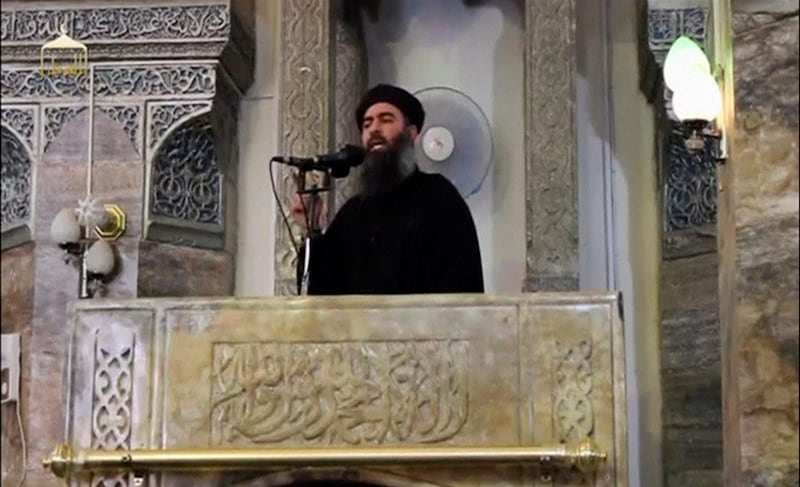“A depraved and dangerous man”: so said US President Donald Trump as the nine-year hunt for ISIS leader Abu Bakr Al Baghdadi came to a dramatic and bloody end, in a network of underground tunnels in northern Syria. The man who terrorised millions of Iraqis and Syrians, brutalised Yazidis, murdered countless victims and eluded the world for the best part of a decade died a coward’s death, driven into a dead end by US special operations forces and blowing himself up with his suicide vest, together with three of his children. The highly secretive mission, carried out on Saturday with the co-operation of Syrian Kurds as well as Iraq, Russia and Turkey, is undoubtedly a significant moment. It marks the end of a chapter that began when Al Baghdadi established ISIS to terrorise Iraqis and Syrians, and culminated in his announcing a false caliphate from the pulpit of Al Nuri mosque in Mosul, Iraq, in 2014. But while his death is an important moment for those who suffered at the hands of ISIS and for the security of the world at large, it does not mean the end of the global threat he represented.
Al Baghdadi was a murky figure living in the shadows and flitting between locations to evade detection. Even though he had only appeared a handful of times in public after founding ISIS from the roots of Al Qaeda in Iraq in 2010, his videos and preachings, broadcast across the internet, had the power to magnetise impressionable followers, who were radicalised worldwide and flocked in their thousands to join his so-called caliphate. Despite the downfall of ISIS, many still avowedly believe in his extremist ideology. Hundreds of thousands of indoctrinated followers, many of them foreign fighters, still dwell in camps in the region and pose a threat of reforming and regrouping. Al Baghdadi might be gone but there will undoubtedly be an equally evil and depraved killer, waiting in the wings to replace him. It would be wrong to think his death signals the end of ISIS. Just as ISIS was born of another extremist group, so its dying embers will undoubtedly ignite another lethal threat, so long as the underlying causes that led to its rise are not addressed.
In March, the US declared victory over ISIS as American troops, aided by the Kurdish-led Syrian Democratic Forces (SDF), quashed the terrorist group in its last bastion of Baghouz. The extremists had already lost all territorial gains in Iraq two years earlier. But while the caliphate might have been decimated, ISIS still has a host of sleeper cells waiting to be reactivated around the world, not just in Syria and Iraq but as far afield as Somalia, Afghanistan and Burkina Faso. From Sri Lanka’s deadly Easter Sunday bombings, which claimed more than 250 lives, to several fatal attacks in the Philippines and sub-Saharan Africa, ISIS is still destroying lives worldwide and perverting the minds of new recruits, even without a territorial stronghold.
Even more worrying are the findings of a report published in July by Operation Inherent Resolve, the US-led operation fighting ISIS. The report found ISIS had “solidified its insurgent capabilities in Iraq and was resurging in Syria” over the previous three months.
Despite these troubling findings, the US has decided to withdraw most of its troops from Syria, leaving its Kurdish ally exposed to a Turkish offensive. As many as 30,000 ISIS members and sympathisers are being held by the SDF in Al Hol camp and thousands more are held in prisons and camps across northern Syria, an area that Turkey wants cleared of Kurdish fighters. ISIS is taking advantage of the chaos to make a comeback. As a result, up to 100 ISIS members have already escaped Al Hol earlier this month.
Given these facts on the ground, while the killing of Al Baghdadi burnishes Mr Trump's reputation ahead of the 2020 election campaign, it serves as more of a badge of honour than an end to the battle against terrorism. There were undoubtedly echoes in Mr Trump's announcement of his predecessor Barack Obama's triumphalism in revealing Osama bin Laden had been hunted down and killed in 2011. But the death of Al Baghdadi serves to underline serious concerns about the US's withdrawal from Syria, at a time when the threat in the region is still very real. More importantly, Al Baghdadi's death at the hands of a declining US force in Syria signals the end of an era in which countries unite to fight ISIS. In 2014, when the terrorist group had made phenomenal gains, the US led an international coalition to fight extremism with the likes of UAE, Saudi Arabia, Jordan, Canada, France, Germany, the UK and Turkey. There is a risk that this time of global co-operation and endeavour could unravel. These efforts must be kept alive because the root causes of ISIS's rise to power, from poverty and conflict to a lack of employment opportunities and disenfranchisement, still thrive and flourish. With fighting ongoing in Syria and a febrile atmosphere in Iraq, the potency for ISIS to re-emerge is great. The global community needs to keep working together in the fight against an ideology that seeks to seed young, impressionable minds and spread once again.






